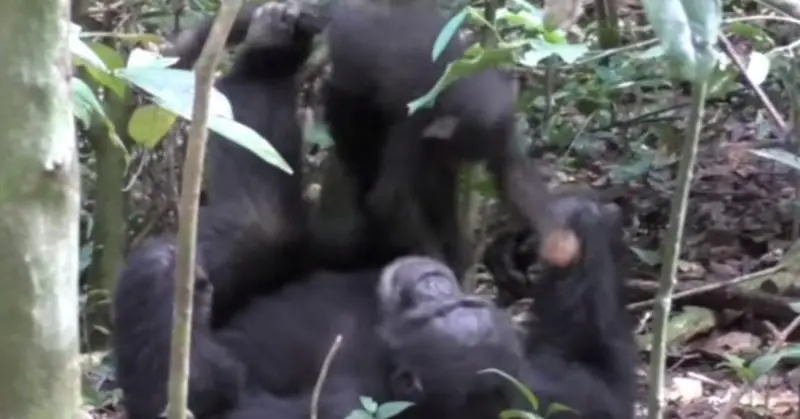In August 2018, hearts warmed on YouTube when an adorable video of a chimpanzee mom playing with her child went viral. The footage was captured by members of the Tai Chimp Project at the Taï National Park in Cote d’Ivoire. The video proves just how closely human babies and adults are related to chimpanzees. [1]
While the mother had most likely never seen any human laying on their backs and playing with their kids, she was captured propping up her baby with her legs and simulating an airplane experiencing turbulence. It was especially adorable when she let the baby drop into her loving arms. She kissed her child and petted him in a most human-like manner. The only difference — she’d been bouncing her baby around with just her legs, where a human would use both the hands and legs to ensure the young one’s safety.
The young chimp also seemed to enjoy the affectionate play as he bounced around, letting his tiny hands flop wildly in the air. This video is all the cuteness you need to see today.
So much in common
Research over the decades has revealed that humans share about 97–99% DNA with chimps and bonobos. [2] We all shared a common ancestor about 6–8 million years ago, but the two species evolved differently. With monkeys and other members of the ape family, we share a more distant relative where the closest connections were from about 25 million years ago.
Humans and chimps are stunningly alike. Besides the physical similarities and display of maternal affection, chimps are capable of critical thought and abstraction despite having smaller brains. They use similar body gestures such as hugging, kissing, and patting one another. Chimps laugh when tickled, express intense emotions, recognize themselves in mirrors, and use their five senses, just as humans do.
A 2018 study published in the journal Animal Cognition reports that human babies and infants share similarities in early communicative gestures with young chimps. [3] Especially between the ages of 1 and 2, young chimps were discovered to use about 89% of the same gestures used by human babies. This percentage is about 46 of the 52 known gestures human babies communicate with, some of which included pointing, head shaking, tapping, stomping, rocking, clapping, smiling, embracing, and even touching.
According to the study which had a sample size of 13 children from Germany and Uganda, human infants are cognitively aware of when they use their gestures to pass on messages. “Like chimpanzees, they used them both singly, and in sequences, and employed individual gestures flexibly towards different goals,” the paper read.
An endangered ancestor
The Tai Chimp Project, founded in 1979 by Christophe and Hedwige Boesch is a prominent international organization focused on the research and conservation of chimps in Africa. Headquartered in Germany, the organization aims to study the behavior and evolution of chimps across the continent with field sites located in Ivory Coast and Gabon.
The video is made more precious by the sad fact that chimp numbers are fast declining in the world, especially across their geographical ranges in Africa. Chimps are native to Central and West Africa and can be found in many countries in the regions including Côte d’Ivoire, DR Congo, Gabon, Senegal, Burkina Faso, Tanzania, Uganda, Rwanda, Central African Republic, Nigeria, and several more.
From the millions that roamed the earth about a century ago, the most recent data reports that about 172,000-300,000 chimps are left in the African wild. [4] Chimps and bonobos are categorized as endangered species on the IUCN red list, suffering problems such as disease-caused mortality, relentless poaching, and habitat destruction.
To help change the chimp situation, you can support the work of conservationists working to protect these animals in their natural habitats. You may visit any of the following trusted foundations listed below to donate or virtually adopt and sponsor a hilarious chimp.
To donate:
- Project Chimps: https://projectchimps.org/donate
- Born Free: https://www.bornfree.org.uk/donate
- Wild Chimps: https://www.bornfree.org.uk/donate
To adopt:
- Born Free: https://www.bornfree.org.uk/adopt
- Save the Chimps: https://www.savethechimps.org/adopt
- Project Chimps: https://projectchimps.org/sponsor-a-chimp
References
- “Video of Baby Chimp Playing ‘Airplane’ with Grown-up Chimpanzee Shows Just How Much They’re Like Humans.” People. Saryn Chorney. Retrieved September 17, 2020.
- “Bonobos Join Chimps as Closest Human Relatives.” Science Mag. Ann Gibbons. Retrieved September 17, 2020.
- “A gestural repertoire of 1- to 2-year-old human children: in search of the ape gestures.” Springer. Kersken et al. Retrieved September 17, 2020.
- “State of the Wild Chimpanzee.” Jane Goodall. Retrieved September 17, 2020.

